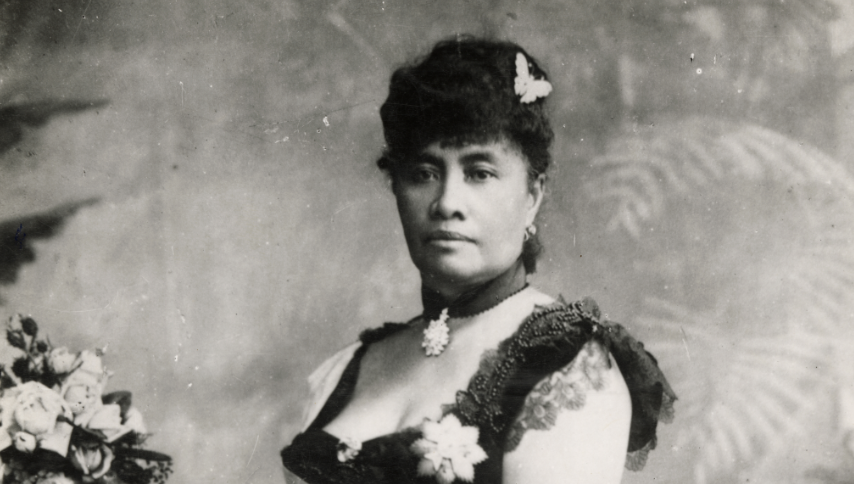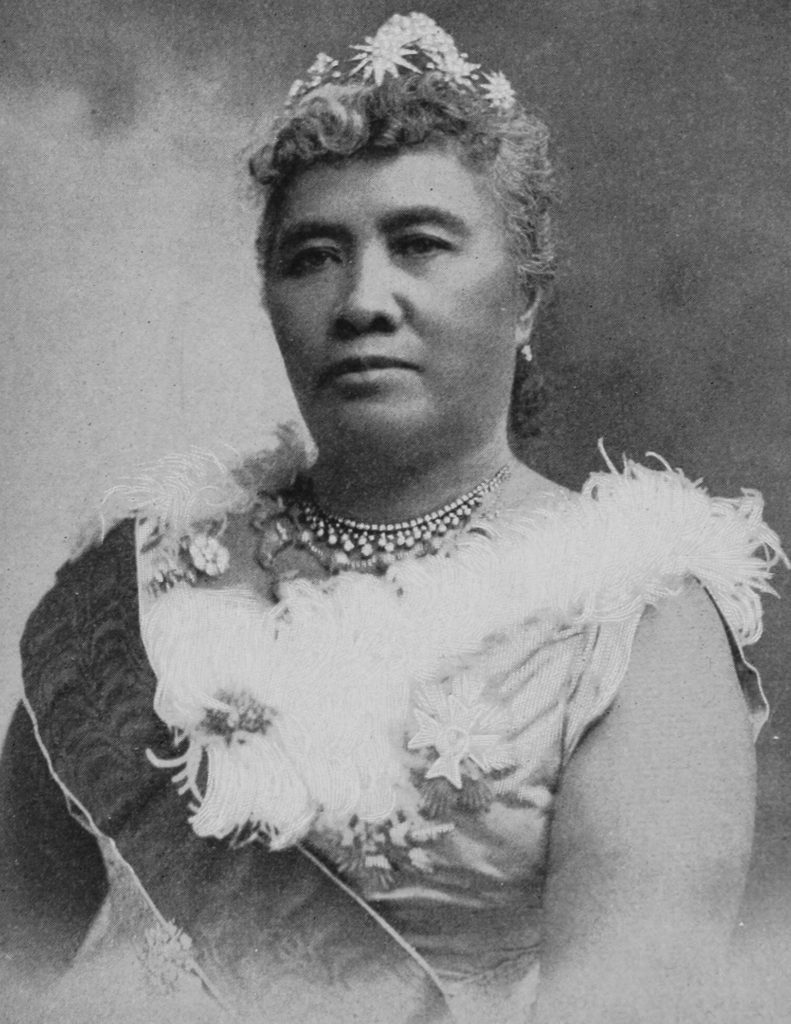
While most of our “Last Queens” series focuses on consorts, this particular last queen was a reigning monarch. Liliuokalani was the only queen regnant and the last monarch of Hawaii before the Hawaiian kingdom was overthrown. It became the shortlived Republic of Hawaii before being annexed by the United States in 1898.
Her Early Life
Lydia Liliʻu Loloku Walania Kamakaʻeha was born on 2 September 1838 in Honolulu to Analea Keohokālole and Caesar Kapaʻakea – Hawaiian nobility – as their third surviving child. She was informally adopted by Abner Pākī and Laura Kōnia at birth. Following Hawaiian custom, her name came from events linked to her birth. The Regent at the time of her birth had an eye infection, and so, she was named Lili’u (meaning smart), Loloku (meaning tearful), Walania (meaning burning pain), and Kamakaʻeha (meaning sore eyes).
She was educated at the Royal School (Chiefs’ Children’s School) and raised as a Christian (her first name Lydia came from her Christian baptism by Reverend Levi Chamberlain). Liliuokalani was declared at age four eligible for the Hawaiian throne (along with her other classmates at the Chiefs’ Children’s School). She learned English from American missionaries with her siblings and cousins while the other subjects were learned at her school.

In 1850, the boarding part of the Royal School was discontinued, and Liliuokalani returned home and attended day school. Her adopted sister married, without parental approval, American Charles Reed Bishop. By 1857, both of Liliuokalani’s adopted parents had died, and she ended up under the guardianship of the Bishops. She then became part of the social elite while King Kamehameha IV was on the throne, and she was a close friend of the woman who married the King and became Queen of Hawaii, Emma Rooke. Liliuokalani was, at one point, considered “the highest unmarried woman in the Kingdom.”
Liliuokalani had been engaged, for a short period, to William Charles Lunalilo but broke it off at the request of the King and the Bishops’ disapproval. She later fell in love with American John Owen Dominis, and they married in an Anglican ceremony on 16 September 1862. They never had biological children, but Liliuokalani adopted three children against her husband’s wishes: Lydia, Joseph and John.
She remained part of the Royal Court after marriage, helped compose the new Hawaiian national anthem and entertained Alfred, Duke of Edinburgh during his visit to Hawaii in 1869.
Path to Queenship
King Kamehameha V died in 1872 with no heir. The Hawaiian Constitution stated that the legislature must elect the next monarch in this instance. They elected William Charles Lunalilo who reigned as Lunalilo until his death in 1874 without issue. The legislature had to elect yet another monarch.
Liliuokalani’s brother, David Kalākaua ran against Queen Emma, and the legislature selected David Kalākaua. However, this resulted in a courthouse riot that led to British and American troops in Hawaii and a strained relationship between Queen Emma and Liliuokalani’s family.
Kalākaua gave his surviving siblings royal styles and titles; he also named his brother as his heir. His brother died three years into his reign, and Liliuokalani was then named heir.
She served as Regent in 1881 while her brother was on a world tour, and she had to handle the smallpox epidemic that hit the islands. She also worked hard in the charitable sector to help her people. Liliuokalani later represented the Kingdom of Hawaii at Queen Victoria’s Golden Jubilee celebrations in 1887. It was while she was in Europe with other members of the family that she found out the King was forced to sign the Bayonet Constitution (which was to strip the monarchy of many of its powers and give them to America, its European allies, and Hawaiian elites) under the threat of death. They immediately returned home to Hawaii.
Embed from Getty ImagesLiliuokalani was approached by politicians that year about making her Queen if they could remove her brother from power. She vowed she turned down the offer while the men said she said she would do it, if necessary.
Liliuokalani became Regent again in November 1890 while King Kalākaua was in California. In January 1891, the King suffered a stroke in Santa Barbara and was rushed to San Francisco where he fell into a coma and died two days later on 20 January 1891.
Liliuokalani, Queen of Hawaii
News of the King’s death did not reach Hawaii until his body returned to the kingdom on the Charleston on 29 January. That day Liliuokalani took the oath to uphold the constitution and became the first and only Queen regnant of Hawaii.

Liliuokalani named her niece, Kaʻiulani as her heir and paid customary visits to all Hawaiian islands from April to July of that year. She also gave her husband, John, the title of Prince Consort and role back as Governor of Oʻahu, but he died seven months into her reign. It affected her deeply as she relied on his advice and companionship for her role. Liliuokalani then named her brother-in-law, Archibald Scott Cleghorn as Governor of Oʻahu and put governors on the other Hawaiian islands. Those selected had been friends and supporters of her.
The Beginning of the End
The Queen helped to rewrite the constitution where the monarchy had its power restored. It also had voting rights given back to native Hawaiians and Asians who were economically disenfranchised. Unfortunately, her ministers and even her closest friends opposed her new constitutional draft, and they attempted to persuade her to not go through with her attempt to get a new constitution.
There was political fallout from the Queen’s attempt to get a new constitution, and people conspired to deposed her. Protests took place in Honolulu, and then royalists gathered to show their support for their monarch. The Queen decided to back down from her attempts to put an end to the protests.
The same day she back off, the Marshal of the Kingdom, Charles Burnett Wilson, learned about a planned coup. He put the kingdom under martial law and issued arrest warrants. The Queen’s cabinet was against the arrests as they feared it would only lead to more unrest. Wilson, members of the Royal Household Guard and US sailors took up positions in Honolulu but did not enter palace grounds; their presence was enough.
The Queen was deposed on 17 January 1893, and she temporarily gave her throne to the US in the hopes the US would restore Hawaii’s sovereignty.
The new provisional government in Hawaii formed the Republic of Hawaii on 4 July that same year.
On 16 January 1895, Queen Liliuokalani was arrested and imprisoned after a failed rebellion to restore her back to the throne by loyalists; weapons were also found on her property. While in prison, she abdicated the throne in exchange for her supporters being released and the commutation of the death sentences of six of the supporters.
The abdication document was signed on 24 January.
The End of the Story
Queen Liliuokalani was put on trial and sentenced to five years hard labour and a $5,000 fine by the military tribunal in February.
In September, her sentence was commuted to imprisonment in the Royal Palace. She was given a full pardon by the Republic of Hawaii on 13 October 1896, and her civil rights were restored.
She went on to write a memoir called “Hawaii’s Story by Hawaii’s Queen.” It was published in 1898.
Embed from Getty ImagesShe ended up splitting her time between Hawaii and the US and tried to get the US to compensate Hawaii and the Royal Family for the problems they had caused. Hawaii was officially annexed to the United States in 1898. It became a US territory two years later and a US state in 1959.
Queen Liliuokalani died on 11 November 1917 in Honolulu. She received a state funeral and is buried in the Royal Mausoleum of Hawaii.

